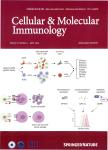TAK1 is essential for MAIT cell development and the differentiation of MA/T1 and MA/T17
作者机构:Center for Cutaneous Biology and Immunology ResearchDepartment of DermatologyHenry Ford HealthDetroitMUSA Immunology Research ProgramHenry Ford Cancer InstituteHenry Ford HealthDetroitMIUSA Department of Internal MedicineHenry Ford HealthDetroitMIUSA Department of MedicineCollege of Human MedicineMichigan State UniversityEast LansingMI 48824USA
出 版 物:《Cellular & Molecular Immunology》 (中国免疫学杂志(英文版))
年 卷 期:2023年第20卷第7期
页 面:854-856页
核心收录:
学科分类:1001[医学-基础医学(可授医学、理学学位)] 100102[医学-免疫学] 10[医学]
基 金:NIH RO1Al119041(QSM) Henry Ford Immunology Program grants(T71016,QSM T71017,LZ) the Henry Ford Cancer Institute Postdoctoral fellowship program(JW and KS)
摘 要:Mucosal-associated invariant T(MAIT)cells are unconventional T cells that have been conserved throughout mammalian evolution,displaying innate and effector-like qualities[1,2].MAIT cells express a semi-invariant T-cell receptor,which recognizes vitamin B metabolites produced by various bacteria and yeast organisms,presented on the restriction molecule major histocompatibility complex(MHC)-related protein-1(MR1)[3].In mice,MAIT cells undergo three developmental stages in the thymus,giving rise to two subsets,MAIT1 and MAIT17,which secrete IFN-and IL-17 to combat infections[4,5].



